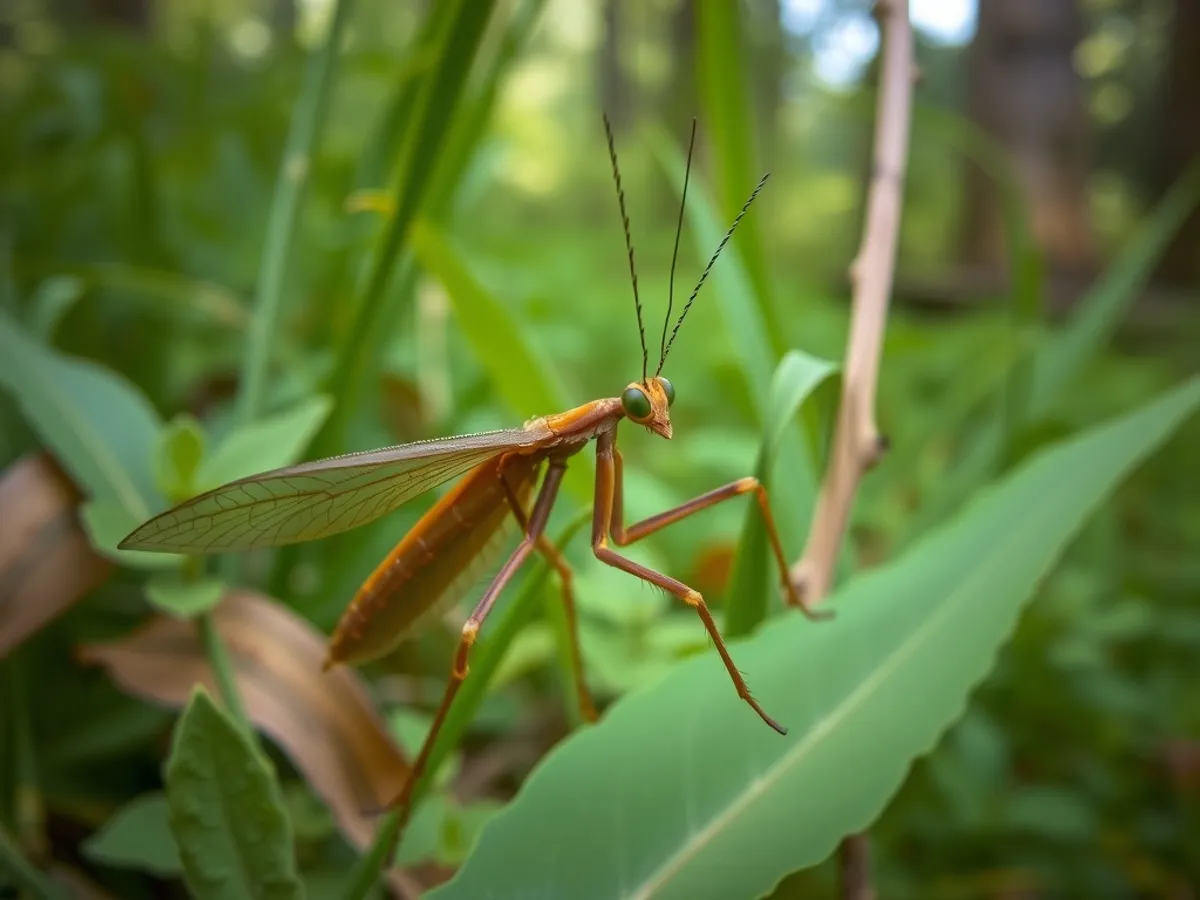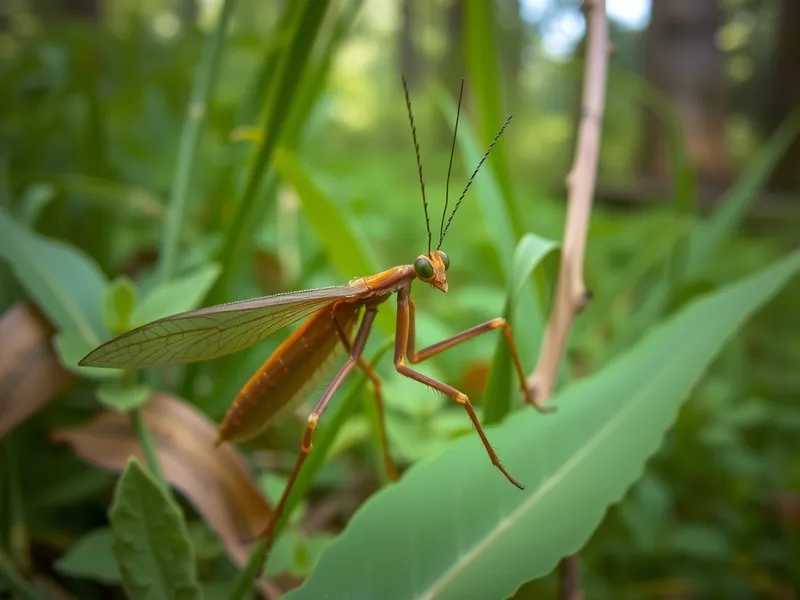
Mantisfly
Mantispidae

Meet the Mantisfly
The mantisfly is a fascinating predatory insect belonging to the family Mantispidae, known for its striking resemblance to both praying mantises and lacewings. These insects possess raptorial forelegs similar to those of mantises, which they use to catch and hold prey, while their delicate wings and body structure mirror those of lacewings. Mantisflies are often found in warm, vegetated environments, hunting for small insects with quick, precise movements. Their larvae are typically parasitic, especially targeting spider egg sacs for development.
Classification
Invertebrate
Habitat
Forests and grasslands with abundant vegetation
Diet
Carnivore
Lifespan
1-2 years
Conservation
Least Concern
Weight
0.01-0.03 grams
📖Fascinating Facts
Spider Parasites
Mantisfly larvae often enter spider egg sacs and consume the developing spider eggs, using them as their primary food source for growth.
Mimicry Experts
Mantisflies have evolved raptorial forelegs and a body shape that closely resembles praying mantises, an example of convergent evolution.
Delicate Wings
Although they look like mantises, mantisflies have transparent, lace-like wings reminiscent of those seen in lacewings and antlions.
📋Detailed Description
Mantidflies (family Mantispidae) are small to medium-sized neuropteran insects, typically ranging from 5 to 25 mm in length. They are instantly recognizable by their elongated prothorax and highly specialized raptorial forelegs, which are structurally and functionally analogous to those of praying mantises—a striking example of convergent evolution. The head is mobile and triangular, with large, well-developed compound eyes providing acute vision for detecting prey. Their membranous wings are often transparent or lightly patterned, with a network of veins characteristic of the Neuroptera order. Adult mantidflies are agile predators, using their forelegs to snatch and immobilize small arthropods, particularly flies, bees, and other soft-bodied insects. The larvae exhibit hypermetamorphosis: the first instar is campodeiform (elongated and mobile), actively seeking out spider egg sacs, while later instars become grub-like and feed on the eggs within. Mantidflies are solitary, with no evidence of social structure or cooperative behavior. They are most active during warm months and are often found resting on vegetation or flowers. Their cryptic coloration and mimicry of wasps or mantises serve as both camouflage and potential deterrence to predators.
💡 Did you know?
Despite their name and appearance, mantisflies are more closely related to lacewings than to praying mantises.
🔬Research & Sources
Wikipedia Summary
Mantispidae, commonly known as mantidflies, mantispids, mantid lacewings, mantisflies or mantis-flies, is a family of small to moderate-sized insects in the order Neuroptera. There are many genera with around 400 species worldwide, especially in the tropics and subtropics. Only five species of Mantispa occur in Europe. As their names suggest, members of the group possess raptorial forelimbs similar to those of the praying mantis, a case of convergent evolution.
Last Modified: 5/26/2025
🎭Behavior & Social Structure
Mantidflies are primarily ambush predators, relying on stealth and rapid strikes to capture prey with their raptorial forelegs. They typically perch on vegetation, remaining motionless until a suitable prey item comes within reach. Their hunting behavior is visually oriented, and they are diurnal, with peak activity during daylight hours. Adults are solitary and exhibit little to no interaction outside of mating. Larvae, after hatching, actively seek out spider hosts, often hitching a ride (phoresy) on adult female spiders to access egg sacs. Once inside the sac, the larva consumes spider eggs, completing development before pupating. Mantidflies are not known to form aggregations or display territoriality.
👶Reproduction & Life Cycle
Reproduction in mantidflies involves complex courtship behaviors, often initiated by the male through antennal tapping and visual displays. Mating typically occurs in late spring or early summer. Females lay clusters of eggs on vegetation, often on the underside of leaves or near spider habitats. The eggs hatch in 1–2 weeks, releasing mobile first-instar larvae. These larvae must quickly locate a suitable spider host, as survival depends on successful parasitism. There is no parental care after oviposition. Development from egg to adult can take several weeks to months, depending on environmental conditions and host availability. Most species are univoltine (one generation per year), though some tropical species may have multiple generations annually.
🛡️Adaptations & Survival
Mantidflies exhibit several remarkable adaptations, including raptorial forelegs with spines for grasping prey, cryptic coloration that mimics wasps or mantises for predator avoidance, and hypermetamorphic larval development. The first-instar larva's mobility and phoretic behavior enable it to locate and infiltrate spider egg sacs, a highly specialized parasitic strategy. Adults have acute vision and rapid reflexes for effective predation. Some species exhibit Batesian mimicry, resembling stinging hymenopterans to deter predators. The ability to remain motionless for extended periods enhances their ambush predation strategy.
📚Research Sources
🎨Cultural Significance
Mantidflies are not prominent in folklore or mythology, likely due to their cryptic habits and resemblance to more familiar insects like mantises and wasps. They are occasionally referenced in entomological literature as examples of convergent evolution and mimicry. In some regions, their presence is noted by naturalists and insect enthusiasts, but they have no known traditional uses or symbolic significance.
🔬Recent Research & Discoveries
Recent studies have focused on the evolutionary relationships within Mantispidae, using molecular phylogenetics to clarify subfamily and genus-level taxonomy. Research has also examined the biomechanics of their raptorial forelegs and the chemical cues used by larvae to locate spider hosts. Ongoing work investigates the ecological role of mantidflies in regulating arthropod populations and their potential as bioindicators of ecosystem health. Fossil records indicate that Mantispidae have existed since the Early Jurassic, providing insights into the evolutionary history of neuropteran insects.
🎥Wildlife Videos

Masters Of Disguise: Meet The Creatures Lurking In The Wilderness | Nature Documentary
Insects use ingenious camouflage and defense mechanisms like mimicry and protective coloration to evade predators and blend ...
All Out Wildlife

Praying Mantis – The Insect Killer | Wild Italy | Episode 4 | Free Documentary Nature
Praying Mantis – The Insect Killer | Wild Italy | Episode 4 | Free Documentary Nature Watch 'Return of the Wolf Packs | Wild Italy ...
Free Documentary - Nature
![The Hidden Mysteries Behind The Dinosaur-Like Insects Of Amazonia | [4K] Wildlife Documentary](https://i.ytimg.com/vi/Y58UtzZNtyU/hq720.jpg?sqp=-oaymwEcCOgCEMoBSFXyq4qpAw4IARUAAIhCGAFwAcABBg==&rs=AOn4CLCLwWX1cKRfcpT6rl3C_AFpQV4GUQ)
The Hidden Mysteries Behind The Dinosaur-Like Insects Of Amazonia | [4K] Wildlife Documentary
A look at the complex relationships of the "mini monsters", insects of the Membracidae family, treehoppers that live amid one of the ...
Wild Habitat - Nature Documentaries

Wildlife - Just Insects | Free Documentary Nature
Wildlife - Episode 5: Just Insects | Wildlife Documentary Watch 'Wildlife - Episode 6' here: https://youtu.be/nfpzQyi9UFU Earth is ...
Free Documentary - Nature

David Attenborough Presents: Tasmania - Weird & Wonderful | Free Documentary Nature
David Attenborough presents: Tasmania - Weird & Wonderful | Wildlife Documentary Watch 'David Attenborough's Ant Mountain' ...
Free Documentary - Nature

Tiny Titans - The Fascinating World of Insects | Free Documentary Nature
Tiny Titans - The Fascinating World of Insects | Wildlife Documentary Watch 'Wildlife - Just Insects' here: ...
Free Documentary - Nature
🌍Habitat Information
The Mantisfly typically inhabits Forests and grasslands with abundant vegetation environments. Mantisflys have adapted to their environments with specialized features and behaviors.
Primary Habitat:
Forests and grasslands with abundant vegetation
More detailed habitat information will be available soon.
🛡️Conservation Status
The Mantisfly is currently classified as Least Concern. Conservation efforts are crucial for preserving this species for future generations.
Common Threats:
- 🏠Habitat loss and fragmentation
- 🌡️Climate change impacts
- 🎯Hunting and poaching
- 🏭Human-wildlife conflict
⚠️Threats & Conservation Challenges
Mantidflies are not currently considered threatened, with most species listed as Least Concern. However, habitat loss due to deforestation, agricultural expansion, and pesticide use can impact local populations, particularly in regions with high biodiversity. Their reliance on specific spider hosts for larval development makes them vulnerable to declines in spider populations. Climate change may also alter their distribution and phenology. Despite these challenges, mantidflies are generally adaptable and maintain stable populations in many areas.
🔬Scientific Classification
Scientific Name
Mantispidae (family; includes multiple genera and species)
Classification Hierarchy
🔍 About Taxonomic Classification
Taxonomic classification is a hierarchical system used by scientists to classify and organize living organisms based on shared characteristics and evolutionary relationships.
The system moves from broad categories (Kingdom) to increasingly specific ones, with each animal's scientific name typically consisting of its Genus and species.
📝Community Notes
Share your observations and insights about the Mantisfly with our community of wildlife enthusiasts.
Join Our Community
Sign in to share your observations and connect with fellow wildlife enthusiasts.
Sign In to ContributeNo community notes yet
Be the first to share your observations about the Mantisfly!
Explore Mantisfly
Select a tab above to learn more about this amazing animal.
📸Photo Gallery
No photos available for this animal yet.
🌟Discover More Wildlife
Continue your journey of discovery with more fascinating animals from our database
